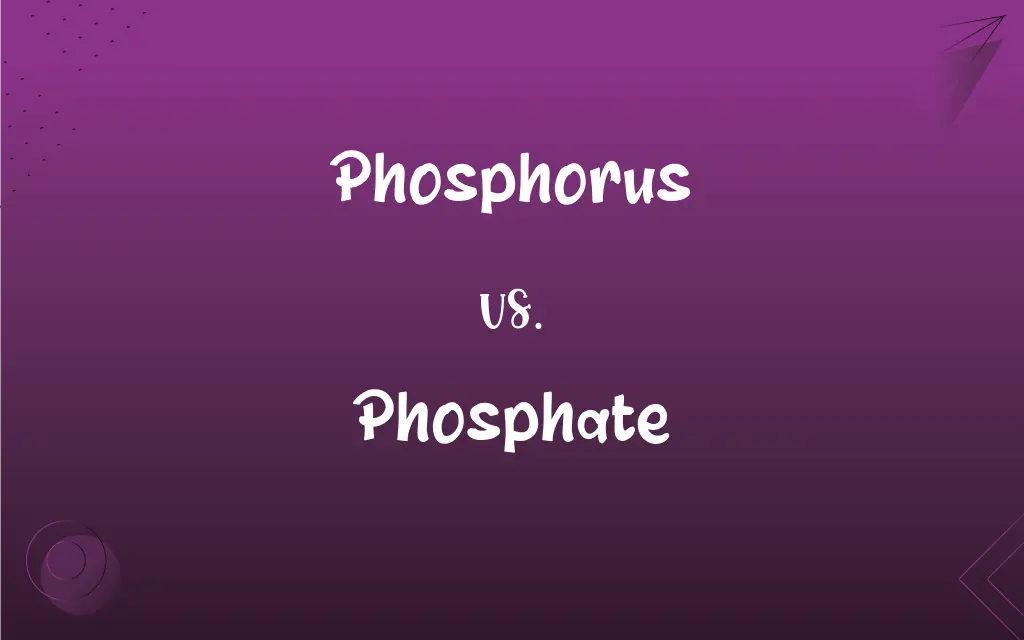Phosphorus vs. Phosphate: What's the Difference?
Edited by Janet White || By Harlon Moss || Updated on October 17, 2023
Phosphorus is a chemical element with symbol P; phosphate is a compound containing the phosphorus atom bonded to oxygen atoms.

Key Differences
Phosphorus is a naturally occurring non-metallic element, vital for life and commonly found in nature. On the other hand, phosphate refers to a compound or salt containing the phosphorus atom bonded to four oxygen atoms.
In its elemental form, phosphorus exists in several allotropic forms, including white, red, and black phosphorus, each with distinct properties. Phosphate, however, plays a significant role in biology, especially in the form of ATP (adenosine triphosphate), which is crucial for energy transfer in cells.
It's important to note that while phosphorus is an essential element for many life forms, it's the phosphate ions that are primarily utilized in biological systems, such as in the formation of bones and teeth.
Industries have different uses for both phosphorus and phosphate. While phosphorus is used in the manufacture of safety matches and pesticides, phosphate compounds are often used in fertilizers, detergents, and food additives.
The environmental impact of these two is notable. Excessive phosphorus and phosphate run-off from agricultural lands can lead to eutrophication in water bodies, causing harmful algal blooms and a decrease in aquatic biodiversity.
ADVERTISEMENT
Comparison Chart
Basic Definition
A chemical element with symbol P.
A compound containing phosphorus atom bonded to oxygen atoms.
Biological Role
Essential element for life.
Crucial for energy transfer in cells (e.g., ATP).
Forms
Exists in white, red, and black allotropic forms.
Exists primarily as salts or esters in nature.
Industrial Uses
Safety matches, pesticides.
Fertilizers, detergents, food additives.
Environmental Impact
Can contribute to eutrophication.
Excessive run-off can lead to harmful algal blooms in water.
ADVERTISEMENT
Phosphorus and Phosphate Definitions
Phosphorus
Exists in several allotropic forms.
Red phosphorus is safer to handle than its white counterpart.
Phosphate
Contains one phosphorus atom bonded to four oxygen atoms.
The phosphate ion plays a pivotal role in biochemistry.
Phosphorus
A non-metallic chemical element of symbol P.
The match industry primarily uses white phosphorus.
Phosphate
A salt or ester derived from phosphoric acid.
Many fertilizers are rich in phosphate.
Phosphorus
An essential nutrient for plants and animals.
Without phosphorus, plants cannot grow properly.
Phosphate
Essential for bone and teeth formation.
Calcium phosphate gives bones their strength.
Phosphorus
A constituent of DNA, RNA, and ATP.
The role of phosphorus in the body is crucial at the cellular level.
Phosphate
Involved in energy transfer in cells.
ATP, or adenosine triphosphate, is a key molecule in cellular energy.
Phosphorus
A reactive element not found freely in nature.
Elemental phosphorus must be processed from phosphate rocks.
Phosphate
Commonly used in detergents and cleaning agents.
Many laundry detergents have reduced phosphate content due to environmental concerns.
Phosphorus
Symbol P A highly reactive, poisonous, nonmetallic element occurring naturally in phosphates, especially apatite, and existing in three allotropic forms, white (or sometimes yellow), red, and black (or violet). An essential element for biological cells, it is used in safety matches, pyrotechnics, incendiary shells, and fertilizers and to protect metal surfaces from corrosion. Atomic number 15; atomic weight 30.9738; melting point (white) 44.15°C; boiling point 280.5°C; specific gravity (white) 1.82, (red) 2.16, (black) 2.25 to 2.69; valence 3, 4, 5. See Periodic Table.
Phosphate
A salt, ester, or anion of phosphoric acid, derived by removal or replacement of one, two, or especially all three of the hydrogens of phosphoric acid.
Phosphorus
A phosphorescent substance.
Phosphate
A fertilizer containing phosphorus compounds.
FAQs
How is elemental phosphorus obtained?
Elemental phosphorus is obtained by processing phosphate rocks.
What is the chemical structure of a phosphate ion?
Phosphate has one phosphorus atom bonded to four oxygen atoms, often represented as PO₄³⁻.
What is the symbol for phosphorus on the periodic table?
The symbol for phosphorus is P.
Are phosphate additives common in foods?
Yes, phosphates are often used as food additives for various purposes, including preservation and pH regulation.
Is phosphorus essential for plant growth?
Yes, phosphorus is a critical nutrient for plants, especially for root development and flowering.
Why is phosphorus vital for living organisms?
Phosphorus is a key component of DNA, RNA, ATP, and cell membranes.
Is phosphorus flammable?
White phosphorus is flammable and can self-ignite in air.
Which foods are rich in phosphorus?
Foods like meat, poultry, fish, nuts, and dairy products are high in phosphorus.
In what forms is phosphate used in agriculture?
Phosphate is primarily used in the form of superphosphate, diammonium phosphate, and monoammonium phosphate fertilizers.
Is there a difference between organic and inorganic phosphorus?
Yes, organic phosphorus is part of living organisms, while inorganic phosphorus exists freely in the environment.
What's the role of phosphate in DNA and RNA?
Phosphate forms the backbone of DNA and RNA molecules, connecting the sugar molecules.
Why are phosphate compounds added to detergents?
Phosphates help in water softening and improving cleaning efficiency, but their use has environmental concerns.
Why is phosphate vital for bones and teeth?
Phosphate combines with calcium to form hydroxyapatite, the mineral matrix of bones and teeth.
What are the primary sources of phosphorus for industrial use?
Phosphate rocks are the main source for extracting phosphorus.
How do phosphate levels affect water bodies?
Excessive phosphate run-off can lead to eutrophication, causing algal blooms and affecting aquatic life.
Why are phosphates added to sodas?
Phosphates can act as acidulants, providing a tangy flavor and controlling the pH of sodas.
Can phosphorus exist freely in nature?
No, due to its reactivity, phosphorus is never found free in nature.
Are there health concerns linked to excess phosphate consumption?
Yes, excessive phosphate intake can impact kidney function and bone health.
Are there any health risks associated with phosphorus deficiency?
Yes, phosphorus deficiency can lead to weak bones, fatigue, and muscle pain.
What's the role of phosphate in cellular energy?
Phosphate is essential in forming ATP, the primary energy currency of cells.
About Author
Written by
Harlon MossHarlon is a seasoned quality moderator and accomplished content writer for Difference Wiki. An alumnus of the prestigious University of California, he earned his degree in Computer Science. Leveraging his academic background, Harlon brings a meticulous and informed perspective to his work, ensuring content accuracy and excellence.
Edited by
Janet WhiteJanet White has been an esteemed writer and blogger for Difference Wiki. Holding a Master's degree in Science and Medical Journalism from the prestigious Boston University, she has consistently demonstrated her expertise and passion for her field. When she's not immersed in her work, Janet relishes her time exercising, delving into a good book, and cherishing moments with friends and family.































































